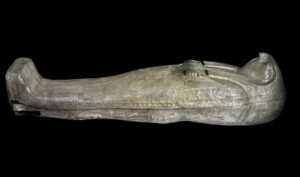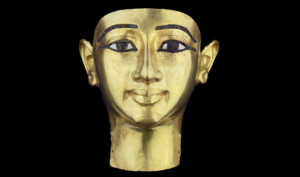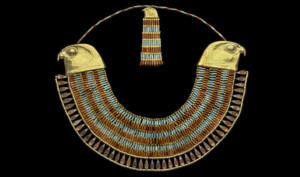MUSEUM QUEST
Journey in the Footsteps of Pharaoh Ramses II and Champollion
Event Overview
To celebrate the bicentennial of Champollion’s decoding of the Rosetta Stone and its hieroglyphs in 1822, the EFBA team is pleased to offer a visit in French to an exceptional exhibition on Ramses the Great and the Gold of the Pharaohs on Sunday, January 15, 2023 at the De Young Museum, as part of our Museum Quest program.
The museum will present the most famous and powerful of the pharaohs, Ramses II the Great, recognized by his contemporaries as a god on earth. Participants will be taken on a journey through the golden age of ancient Egypt.
The exhibition will focus on the life of Ramses and will allow the children to discover the largest collection of objects that belonged to him and to go back several millennia. The mummified animals and certain treasures recently discovered in the royal necropolis of Dahshur and Tanis will no longer hold any secrets for them!
Teaching Objectives
Through this event, participants will:
- Discover Ramses II and the important stages of his life.
- Gain knowledge about ancient Egypt.
- Learn about the characteristics of the buildings, sculptures and jewelry of this golden age of Egypt.
- Be introduced to Champollion’s discovery of the key to deciphering hieroglyphics.
Cultural Focus:
Ancient Egypt
Ancient Egypt is an ancient civilization of North-East Africa, concentrated along the lower course of the Nile, in what constitutes Egypt today. Its civilization takes shape around -3150 with the political unification of Upper Egypt in the south and Lower Egypt in the north under the reign of the first king and developed over more than three millennia.
The strength of this civilization lay in its ability to control the Nile, which generated income that favored its cultural, social and administrative expansion. In spite of numerous successions of prosperous periods and more chaotic periods, ancient Egypt lasted more than 3000 years.
Pharaoh, the divine representative on earth, directed the administration of the State and the religious order, which allowed him to ensure the unity of the people. Ancient Egypt is credited with many achievements in mining, surveying and building techniques that facilitated the construction of monumental pyramids, temples and obelisks. Also to their credit are the development of mathematics, medicine, irrigation and agricultural production, the construction of the first known ships, Egyptian earthenware, and new forms of literature.
The reign of the pharaohs officially ended in 30 BC with the conquest of Egypt by the Roman Empire.



Who was Ramses II?
 Born around -1304 and died in Pi-Ramses around -1213, he is the third pharaoh of the XIXth Egyptian dynasty. He reigned from 1279 BC to 1213 BC. He is also called Ramses the Great or Ozymandias. His reign lasted 66 years and was exceptionally long for the time.
Born around -1304 and died in Pi-Ramses around -1213, he is the third pharaoh of the XIXth Egyptian dynasty. He reigned from 1279 BC to 1213 BC. He is also called Ramses the Great or Ozymandias. His reign lasted 66 years and was exceptionally long for the time.
He is one of the most outstanding pharaohs because of the numerous monuments that he erected throughout the country. He was also nicknamed “The builder pharaoh.” We owe him in particular the construction of the temple of Amun at Ouadi, the temple of Gerf Hussein, the temple of Derr and especially the two temples of Abu Simbel (one dedicated to his favorite queen and the other to the protective gods of the empire). In order to deify his person, he even inscribed his name on the constructions of his predecessors.
Among all these constructions, he built ports and arsenals to prepare his expeditions. As a great warrior, he participated in extending the kingdom and restoring the greatness of Egypt.
The tomb of Ramses II was discovered in 1737 in the Valley of the Kings.
DETAILS
When:
Due to high demand, we will offer two tours on the same day:
- Sunday, January 15, 2023 – 9:30 am to 11 am PST – SOLD OUT
- Sunday, January 15, 2023 – 11:30 am to 1:00 pm PST
Where: De Young museum – Golden Gate Park 50 Hagiwara Tea Garden Drive, San Francisco, CA 94118
Schedule of the event:
- 9:00 am or 11:30 am (depending on the time at which your child is registered): arrival of the families in front of the museum (De Young museum: Golden Gate Park \ 50 Hagiwara Tea Garden Drive, San Francisco, CA 94118)
- 9:30 am to 11 am or 11:30 am – 1:00 pm: visit of the exhibition
- 11:05 am or 1:05 pm: families pick up their child(ren) in front of the museum
Who: Children ages 6-12 with prior knowledge of French (2 years minimum). Assessment required for students not enrolled in a 2021-2022 EFBA program.
To join us, participants should be able to:
- Express himself/herself clearly and comfortably in French.
- Easily understand the main ideas in a conversation on a range of topics.
Questions about your child’s level? Email admissions@efba.us before registration.
During the visit, what do participants need?
- Comfortable shoes.
- And that’s it!



REGISTRATION
Only 7 spots available, so register today!
Children who receive an EFBA scholarship:
- FREE for children with a scholarship
